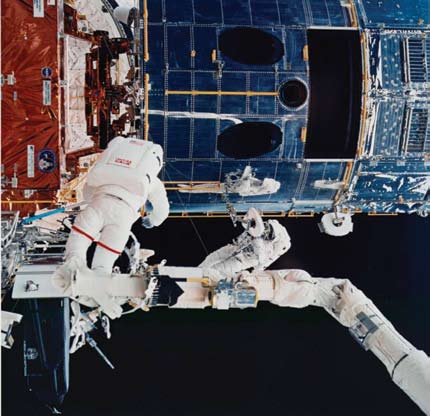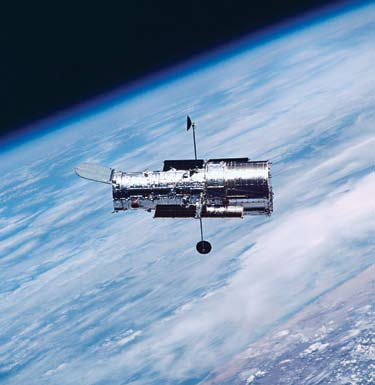
Astronauts Story Musgrave and Jeff Hoffman repair Hubble in 1993
Star Power
by Walter Cunningham
The Hubble Space Telescop[e is a modern marvel—and a testament to why manned space missions are necessary
The first 50 years of NASA have been marked by three stellar events—man’s landing on the Moon, the sojourn of the Spirit and Opportunity rovers on the planet Mars, and the Hubble Space Tele-scope’s eye on the universe. These stand out because of the unique way each of them has clutched at our emotions and affected our thinking. They have contributed to NASA becoming one of the most success-ful government agencies in history.
The Apollo 11 landing will go down in history as the greatest accomplishment of the 20th Century. Neil Arm-strong’s first steps on the Moon were the culmination of man’s escape from the Earth’s gravitational pull to land on another body in the universe. We turned a truly audacious undertaking into another milestone in the history of our country.
The Spirit and Opportunity rovers have allowed us to explore, vicariously, the surface of Mars, our next destination in space. The planned three-month lifetimes of two small rovers has stretched into four years of pictures, data, and telepresence. We now understand the Martian environment far better than we did the Moon in 1961 when we targeted that body for a visit.
The Hubble Space Telescope (HST) may have had the most profound impact not only on science but on our emotions as well. It has been 15 years since my household stayed up into the wee hours of the morning watching Story Musgrave and Jeff Hoffman as they operated on Hubble to restore its vision. We were joined by millions of others watching live televi-sion of the first-ever repair mission in orbit. It had taken 18 years to bring the Hubble from design to launch stage in 1990. Then … near disaster. A problem with the lens made it appear the space telescope was going to be a billion-dollar flop. Instead, in 1993, Story and Jeff’s spectacular EVAs succeeded in installing corrective optics and turned the Hubble Space Telescope into one of the most remarkable facili-ties in the history of science. In the ensuing 15 years, through two more servicing missions, this truly miraculous piece of machinery has rewritten the astronomy books and our understanding of the universe. A number of its major discoveries have overthrown earlier assumptions and under-standings about the universe. Hubble’s spectacular and often awe-inspiring images and findings are responsible for more than 35 percent of NASA’s total scientific output.

Astronauts Story Musgrave and Jeff Hoffman repair Hubble in 1993
That first human servicing mission turned Hubble into arguably the most important telescope in history. Many of its amazing findings were not even suspected when the telescope was planned. Hubble has shown us galaxies on the very threshold of being formed, confirmed the presence of gravita-tional lenses, and proven the existence of “dark energy” that drives galax-ies apart faster over time. With the successful completion of the upcoming fourth servicing mission (SM4), Hubble could continue these breakthrough scientific observations well into the next decade.
A distinguished panel of astronomers concluded the Hubble Space Tele-scope “has arguably had a greater impact on astronomy than any instru-ment since the original astronomical telescope of Galileo.” The SM4 mis-sion to repair and upgrade Hubble is an attempt to continue that record.
The SM4 mission was originally scheduled for 2004 or 2005. Just two days after President George W. Bush’s 2004 announcement of his “Moon, Mars and Beyond” initiative, NASA Administrator Sean O’Keefe announced he was canceling SM4. He claimed it was “too risky” and cited the time and money that could be diverted to the new initiative if Hubble was abandoned. Following the 2003 Columbia disaster, O’Keefe refused to launch a mission into any orbit from which the crew could not reach a safe haven at the Inter-national Space Station. All remaining shuttle missions were to be dedicated to completion of the ISS, in spite of the fact that Hubble’s contribution to scientific knowledge greatly exceeds that of the ISS.

The Hubble Space Telescope as seen from STS-109 in 2002
Public outcry over abandoning the Hubble drowned out support for the new space initiative. A few months later, with the signa-tures of 26 former astronauts, I managed to get a petition into the hands of President Bush, urging him to reinstate SM4. Many others joined the uproar, but nothing changed until 2005, when new NASA Administrator Mike Griffin agreed to take a fresh look at extending the life of the greatest telescope in history.
When Griffin reinstated SM4 in October 2006 many of us breathed a sigh of relief, but we have also been holding our breath, hoping that Hubble will be repaired before its last gyro fails and it goes unstable. The final service call to this unique observatory is sched-uled for October.
Over the course of five strenuous spacewalks, astronauts will replace gyros and batteries and repair cameras and equipment that have degraded or failed, including the Advanced Camera for Surveys, which has produced many of the Hubble’s most dramatic images. They will also attach a de-orbit motor that will even-tually be used to safely maneuver Hubble toward reentry over the ocean.
SM4 will also deliver two new instruments that will amplify the telescope’s capabilities by allowing new observations in two under-exploited spec-tral regions. The Cosmic Origins Spectrograph will fill important gaps in our understanding of the birth and death of stars in nearby galaxies and do it 10 to 100 times faster; the Wide Field Camera 3 will increase Hubble’s discovery efficiency for ultraviolet and near-infra-red imaging by factors of 10 to 30.
The accomplishments of Hubble have been a ringing endorsement of the value of human beings in space. Had Hubble not been designed for servicing by astronauts, it would have been an epic failure and a disaster for a generation of astronomers and astrophysicists.
With a successful SM4 mission, Hubble should continue making breakthrough scientific obser-vations well into the next decade. Hopefully, by then we will have a worthy successor ready to replace it.
If the launch of Sputnik, 50 years ago, taught us anything, it should be that the United States must continue to be at the forefront of science and technology. Our focus must be on knowl-edge, technological breakthroughs, inspiration, the economy, national security, etc. Cost cannot be the overriding issue, an imperative that was brought frighteningly home back in the 1960s.
The Moon landings changed the way we thought of ourselves; the Mars Rovers changed the way we see our solar system; and the Hubble Space Telescope has changed the way we look at the universe.
As we celebrate the 50th anniversary of NASA, we can look forward to many more spectacular surprises, thanks to this final Hubble servicing mission.